1st Academy Awards
The 1st Academy Awards ceremony, presented by the Academy of Motion Picture Arts and Sciences (AMPAS), honored the best films of 1927 and 1928 and took place on May 16, 1929, at a private dinner held at the Hollywood Roosevelt Hotel in Los Angeles, California. AMPAS president Douglas Fairbanks hosted the show. Tickets cost $5 (which would be $74 in 2019, considering inflation), 270 people attended the event and the presentation ceremony lasted 15 minutes. Awards were created by Louis B. Mayer, founder of Louis B. Mayer Pictures Corporation (at present merged into Metro-Goldwyn-Mayer). It is the only Academy Awards ceremony not to be broadcast either on radio or television. The radio broadcast was introduced the following year in 1930.
| 1st Academy Awards | |
|---|---|
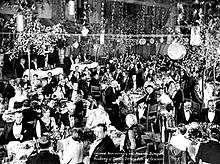 The first Academy Awards ceremony was held at the Hollywood Roosevelt Hotel. | |
| Date | May 16, 1929 |
| Site | Hollywood Roosevelt Hotel Hollywood, Los Angeles, California, U.S. |
| Hosted by | Douglas Fairbanks |
| Highlights | |
| Best Picture | Wings[1] |
| Most awards | 7th Heaven and Sunrise (3 each) |
| Most nominations | 7th Heaven (5) |
During the ceremony, AMPAS presented Academy Awards – now known as the Oscars – in 12 categories. Winners were announced three months before the live event. Some nominations were announced without reference to a specific film, such as for Ralph Hammeras and Nugent Slaughter, who received nominations in the now defunct category of Engineering Effects.[2] Unlike later ceremonies, an actor could be awarded for multiple works within a calendar year for the same category. Emil Jannings, for example, was given the Best Actor award for his work in both The Way of All Flesh and The Last Command. Also, Charlie Chaplin and Warner Brothers each received an Honorary Award.[3][4]
Major winners at the ceremony included 7th Heaven and Sunrise, which each received three awards, and Wings, receiving two awards. Among its honors, Sunrise won the award for Unique and Artistic Picture, and Wings won the award for Outstanding Picture (now known as Best Picture). These two categories at the time were regarded equally as the top award of the night, intended to honor different and important aspects of superior filmmaking. The next year, the Academy dropped the Unique and Artistic Picture award, and decided retroactively that the award won by Wings was the highest honor that could be awarded.[2]
Background
In 1927, the Academy of Motion Picture Arts and Sciences (AMPAS) was established by Louis B. Mayer, originator of Louis B. Mayer Pictures Corporation, which then would be joined into Metro-Goldwyn-Mayer (MGM). Mayer's purpose in creating the award was to unite the five branches of the film industry, including actors, directors, producers, technicians, and writers.[5] Mayer commented on the creation of the awards "I found that the best way to handle [filmmakers] was to hang medals all over them ... If I got them cups and awards, they'd kill them to produce what I wanted. That's why the Academy Award was created".[6] Mayer asked Cedric Gibbons, art director of MGM, to design an Academy Award trophy.[5][7] Nominees were notified through a telegram in February 1928.[5] In August 1928, Mayer contacted the Academy Central Board of Judges to decide winners.[5] However, according to the American director King Vidor, the voting for the Academy Award for Best Picture was in the hands of the AMPAS founders Douglas Fairbanks, Sid Grauman, Mayer, Mary Pickford, and Joseph Schenck.[8]
Ceremony
The ceremony was held on May 16, 1929[9][3][4][10] at the Hollywood Roosevelt Hotel, located in Los Angeles.[3] It consisted of a private dinner with 36 banquet tables,[11] where 270 people attended and tickets cost five dollars (equivalent to $74.45 in 2019).[3] Actors and actresses arrived at the hotel in luxury vehicles, where many fans attended to encourage celebrities.[11] The ceremony was not broadcast on radio or television,[3] and was hosted by AMPAS director Fairbanks[9][3][4][12] during a 15-minute event.[10]
Overview
Winners were announced three months before the ceremony.[3][4][10] The recipients included: Emil Jannings, the inaugural first award recipient[3] for Best Actor (The Way of All Flesh and The Last Command);[4][10] Janet Gaynor for Best Actress (7th Heaven, Street Angel, and Sunrise: A Song of Two Humans); Frank Borzage for Best Director, Drama (7th Heaven); Lewis Milestone for Best Director, Comedy (Two Arabian Knights); and Wings for Best Picture (the most expensive film of its time).[9][2] Two presentations were made of a Special Award: Charlie Chaplin, a multiple nominee for one movie (Best Actor, Best Writer and Best Director, Comedy; all for The Circus) having been removed from the list so as to recognize his total contribution to the industry;[4] and Warner Brothers, an award for pioneering talking pictures (The Jazz Singer). Three categories were eliminated for subsequent presentations: Best Engineering Effects, Best Title Writing, and Best Unique and Artistic Quality of Production.[2] The larger film producers received the preponderance of awards: Fox Film Corporation, Metro-Goldwyn-Mayer, Paramount Pictures, Radio-Keith-Orpheum, and Warner Bros.[5]
Academy Awards of Merit
At the 1st Academy Awards (1927–1928), an anomaly in the nomination process allowed for an artist to be nominated – and to be awarded – for work in a single film, for work across multiple films, or for work without reference to any specific film.
Winners are listed first, in boldface, and indicated with an asterisk (*).
Outstanding Picture
|
Best Unique and Artistic Picture
|
|
|
|
|
Best Writing (Original Story)
|
Best Writing (Adaptation)
|
Best Art Direction
|
Best Cinematography
|
Best Engineering Effects
|
Best Writing (Title Writing)
|
- Notes
- The Circus originally received four nominations: one for Outstanding Picture (Charles Chaplin, producer) and three additional nominations – Best Director (Comedy Picture), Best Actor, and Best Writing (Original Story) – for Charles Chaplin. However, the Academy subsequently decided to remove Chaplin's name from the competitive award categories and instead to confer upon him a Special Award "for acting, writing, directing and producing The Circus".
- Gerald Duffy's nomination for Best Writing (Title Writing) was a posthumous nomination.
Honorary Awards
The following Honorary Awards – then called Special Awards – were conferred:
- Charles Chaplin – "To Charles Chaplin, for acting, writing, directing and producing The Circus".[3]
- Warner Bros. – "To Warner Bros., for producing The Jazz Singer, the pioneer outstanding talking picture, which has revolutionized the industry."[3]
Multiple nominations and awards
Changes to Academy Awards
After the 1st Academy Awards (1927–1928), the following changes were made by AMPAS.
- Award categories were reduced from twelve to seven.
- The awards for Best Directing (Comedy Picture) and Best Directing (Dramatic Picture) were merged into a single Best Directing award.
- The award for Best Engineering Effects was discontinued.
- The award for Best Unique and Artistic Picture was discontinued.
- The awards for Best Writing (Adaptation) and Best Writing (Original Story) were merged into a single Best Writing award.
- The award for Best Writing (Title Writing) was discontinued.
Gallery
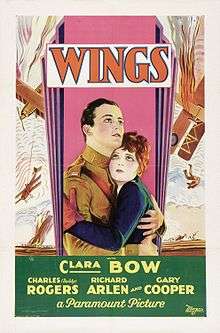 Wings is the first film to win the Academy Award for Best Picture, which was at the time known as Outstanding Picture. Also won an award for the Best Engineering Effects[9]
Wings is the first film to win the Academy Award for Best Picture, which was at the time known as Outstanding Picture. Also won an award for the Best Engineering Effects[9]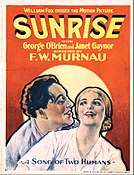 Sunrise won the Academy Award for Best Unique and Artistic Picture, the only year that such a prize was awarded. The prize was intended to honor prestige art films separately from "commercial fare".[13]
Sunrise won the Academy Award for Best Unique and Artistic Picture, the only year that such a prize was awarded. The prize was intended to honor prestige art films separately from "commercial fare".[13]- Frank Borzage, Best Directing (Dramatic Picture)
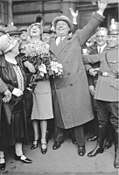 Emil Jannings, Best Actor
Emil Jannings, Best Actor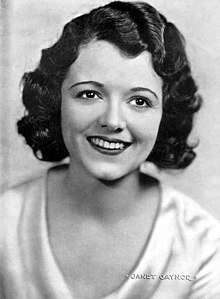 Janet Gaynor, Best Actress
Janet Gaynor, Best Actress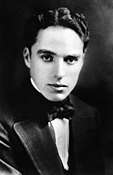 Charles Chaplin, Honorary Award
Charles Chaplin, Honorary Award Warner Brothers Production, Honorary Award. In top image First National Studios, Burbank, c. 1928.
Warner Brothers Production, Honorary Award. In top image First National Studios, Burbank, c. 1928.
See also
- 1927 in film
- 1928 in film
References
- "The 1st Academy Awards Memorable Moments". Academy of Motion Picture Arts and Sciences.
- "The Official Academy Awards Database". Academy of Motion Picture Arts and Sciences. Retrieved November 11, 2019. Reader must select "1927/28" in the "Award Year(s):" drop-down menu and press "Search".
- "History of the Academy Awards". Academy of Motion Picture Arts and Sciences. Archived from the original on April 8, 2010. Retrieved May 6, 2010.
- Dirks, Tim. "1927–28 Academy Awards Winners and History". Filmsite. Rainbow Media. Archived from the original on July 24, 2010. Retrieved May 6, 2010.
- Cosgrave 2007, p. 1
- Eyman 2005, p. 117
- Eyman 2005, p. 209
- Eyman 2005, p. 138
- "This day in History". History. A&E Television Networks. Archived from the original on March 7, 2010. Retrieved October 5, 2010.
- Pawlak, Debra Ann. "The Story of the First Academy Awards". The MediaDrome. Archived from the original on March 15, 2005.CS1 maint: ref=harv (link)
- Cosgrave 2007, p. 4
- "Names make news". Time. Time Inc. May 27, 1929. Archived from the original on October 27, 2010. Retrieved October 5, 2010.
- Decherney, Peter (August 14, 2012). Hollywood and the Culture Elite: How the Movies Became American. Columbia University Press. ISBN 9780231508513 – via Google Books.
Bibliography
- Cosgrave, Bronwyn (2007). Made for Each Other: Fashion and the Academy Awards (I ed.). New York, United States: Bloomsbury Publishing USA. ISBN 978-0-7475-7630-3. OCLC 74523691.CS1 maint: ref=harv (link)
- Eyman, Scott (2005). Lion of Hollywood: the life and legend of Louis B. Mayer (I ed.). New York, United States: Simon & Schuster. ISBN 0-7432-0481-6. OCLC 57506846.CS1 maint: ref=harv (link)